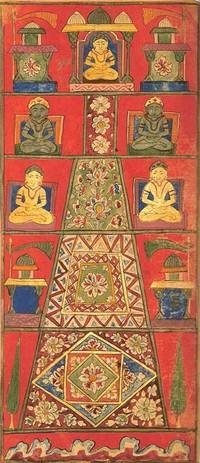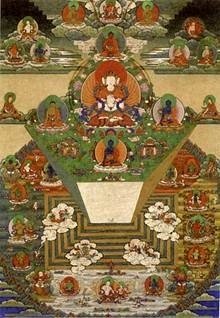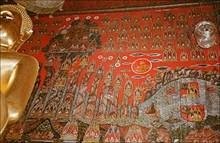From Wikipedia, the free encyclopedia
Mount Meru (Sanskrit: मेरु), also called Sumeru (Sanskrit) or Sineru (Pāli) or ཪི་རྒྱལ་པོ་རི་རབ་ (in Tibetan) to which is added the approbatory prefix su-, resulting in the meaning “excellent Meru” or “wonderful Meru” and Mahameru i.e. “Great Meru” (Chinese: 須彌山 Xumi Shan, Japanese: 須弥山 Shumi-sen, Pāli Neru, Burmese: Myinmo), is a sacred mountain with five peaks[1] in Hindu, Jain as well as Buddhist cosmology and is considered to be the center of all the physical, metaphysical and spiritual universes.
Many famous Hindu and similar Jain as well as Buddhist temples have been built as symbolic representations of this mountain. The highest point (the finial bud) on the pyatthat, a Burmese-style multi-tiered roof, represents Mount Meru.
Painting of Mount Meru as per Jain cosmology from Jain text Samghayanarayana loose-leaf manuscript
Bhutanese thanka of Mount Meru and the Buddhist Universe, 19th century, Trongsa Dzong, Trongsa, Bhutan
A mural depicting Mt. Meru, in Wat Sakhet, Bangkok, Thailand
Geographical
The dimensions attributed to Mount Meru, all the references to it being as a part of the Cosmic Ocean, along with several statements like that the Sun along with all the planets (including Earth itself) circumambulate the mountain, make determining its location most difficult, according to most scholars.[2][3]
Some researchers identify Mount Meru or Sumeru with the Pamirs, north-west of Kashmir. The Suryasiddhanta mentions that Mt Meru lies in ‘the middle of the Earth’ (“Bhugol-madhya”) in the land of the Jambunad (Jambudvip). Narpatijayacharyā, a 9th-century text, based on mostly unpublished texts of Yāmal Tantr, mentions “Sumeruḥ Prithvī-madhye shrūyate drishyate na tu” (‘Su-meru is heard to be in the middle of the Earth, but is not seen there’).[14] Vārāhamihira, in his Panch-siddhāntikā, claims Mt Meru to be at the North Pole (though no mountain exists there as well). Suryasiddhānt, however, mentions a Mt Meru in the middle of Earth, besides a Sumeru and a Kumeru at both the Poles.
There exist several versions of Cosmology in existing Hindu texts. In one of them, cosmologically, the Meru mountain was also described as being surrounded by Mandrachal Mountain to the east, Supasarv Mountain to the west, Kumuda Mountain to the north and Kailash to the south.[15]
Sanatana Dharma legends
Mount Meru of Hindu traditions has clearly mythical aspects, being described as 84,000 Yojan high (which is around 1,082,000 km (672,000 mi), or 85 times the Earths’s diameter), and having the Sun along with all its planets in the Solar System revolve around it as one unit.
One Yojana can be taken to mean about 11.5 km (9 mi) though its magnitude seems to differ over time periods. E.g. the Earth’s circumference is 3,200 Yojanas according to Vārāhamihira and slightly less so in the Āryabhatiya, but is given to be 5,026.5 Yojanas in the Suryasiddhānta. The Matsya Purana and the Bhāgvata Purāna along with some other Hindu texts consistently give the height of 84,000 Yojanas to Mount Meru which translates into 672,000 miles or 1.082 million kilometers.
Mount Meru is also the abode of Lord Brahma and the Demi-Gods (Dev).
Buddhist legends
A Korean world map centered on the legendary Mount Meru in Central Asia.
According to Vasubandhu‘s Abhidharmakośabhāṣyam, Sumeru is 80,000 yojanas tall. The exact measure of the yojana is uncertain, but some accounts put it at about 24,000 feet, or approximately 4 1⁄2 miles, but other accounts put it at about 7–9 miles. It also descends beneath the surface of the surrounding waters to a depth of 80,000 yojanas, being founded upon the basal layer of Earth. Sumeru is often used as a simile for both size and stability in Buddhist texts.
Sumeru is said to be shaped like an hourglass, with a top and base of 80,000 yojanas square, but narrowing in the middle (i.e., at a height of 40,000 yojanas) to 20,000 yojanas square.
Sumeru is the polar center of a mandala-like complex of seas and mountains. The square base of Sumeru is surrounded by a square moat-like ocean, which is in turn surrounded by a ring (or rather square) wall of mountains, which is in turn surrounded by a sea, each diminishing in width and height from the one closer to Sumeru. There are seven seas and seven surrounding mountain-walls, until one comes to the vast outer sea which forms most of the surface of the world, in which the known continents are merely small islands. The known world, which is on the continent of Jambudvipa, is directly south of Sumeru.
The dimensions stated in the Abhidharmakośabhāṣyam are shown in the table below:
|
Name |
Width |
Height/Depth |
|
Sumeru (Sineru) mountain |
80,000 yojanas |
80,000 yojanas |
|
Sea |
80,000 yojanas |
80,000 yojanas |
|
Yugandhara mountains |
40,000 yojanas |
40,000 yojanas |
|
Sea |
40,000 yojanas |
40,000 yojanas |
|
Iṣadhara (Isadhara) mountains |
20,000 yojanas |
20,000 yojanas |
|
Sea |
20,000 yojanas |
20,000 yojanas |
|
Khadiraka (Karavīka) mountains |
10,000 yojanas |
10,000 yojanas |
|
Sea |
10,000 yojanas |
10,000 yojanas |
|
Sudarśana (Sudassana) mountains |
5,000 yojanas |
5,000 yojanas |
|
Sea |
5,000 yojanas |
5,000 yojanas |
|
Aśvakarṇa (Assakaṇṇa) mountains |
2,500 yojanas |
2,500 yojanas |
|
Sea |
2,500 yojanas |
2,500 yojanas |
|
Vinadhara (Vinataka) mountains |
1,250 yojanas |
1,250 yojanas |
|
Sea |
1,250 yojanas |
1,250 yojanas |
|
Nimindhara (Nemindhara) mountains |
625 yojanas |
625 yojanas |
|
Outer Sea |
32,000 yojanas |
relatively shallow |
|
Cakravāḍa (Cakkavāḷa) mountains (circular edge of the world) |
312.5 yojanas |
312.5 yojanas |
The 80,000 yojana square top of Sumeru constitutes the Trāyastriṃśa “heaven” (devaloka), which is the highest plane in direct physical contact with the earth. The next 40,000 yojanas below this heaven consist of sheer precipice, narrowing in like an inverted mountain until it is 20,000 yojanas square at a height of 40,000 yojanas above the sea.
From this point Sumeru expands again, going down in four terraced ledges, each broader than the one above. The first terrace constitutes the “heaven” of the Four Great Kings and is divided into four parts, facing north, south, east and west. Each section is governed by one of the Four Great Kings, who faces outward toward the quarter of the world that he supervises.
40,000 yojanas is also the height at which the Sun and Moon circle Sumeru in a clockwise direction. This rotation explains the alteration of day and night; when the Sun is north of Sumeru, the shadow of the mountain is cast over the continent of Jambudvīpa, and it is night there; at the same time it is noon in the opposing northern continent of Uttarakuru, dawn in the eastern continent of Pūrvavideha, and dusk in the western continent of Aparagodānīya. Half a day later, when the Sun has moved to the south, it is noon in Jambudvīpa, dusk in Pūrvavideha, dawn in Aparagodānīya, and midnight in Uttarakuru.
The next three terraces down the slopes of Sumeru are each longer and broader by a factor of two. They contain the followers of the Four Great Kings, namely nāgas, yakṣas, gandharvas, and kumbhāṇḍas.
The names and dimensions of the terraces on the lower slopes of Sumeru are given below:
|
Name |
Height above the sea |
Breadth |
Length (on one side) |
|
40,000 yojanas |
2,000 yojanas |
24,000 yojanas |
|
|
Sadāmada |
30,000 yojanas |
4,000 yojanas |
32,000 yojanas |
|
Mālādhara |
20,000 yojanas |
8,000 yojanas |
48,000 yojanas |
|
Karoṭapāni |
10,000 yojanas |
16,000 yojanas |
80,000 yojanas |
Below Sumeru, in the seas around it, is the abode of the Asuras who are at war with the Trāyastriṃśa gods.
Puranic legends
An attempt to depict the cosmology of the Puranas, and Mount Meru, provenance and exact date unknown
Mount Meru finds mention innumerable times in Hindu lore. Some of the better-known legends are recounted here. Legends say that Mount Meru and the wind god Vayu were good friends. However, the sage Narada approached Vayu and incited him to humble the mountain. Vayu blew with full force for one full year, but Meru was shielded by Garuda with his wings (he was flying high). However, after a year Garuda took respite for some time. Thus the apex of the mountain was broken and it fell into the sea and created the island of Lanka.
Mount Meru was said to be the residence of King Padamja Brahma in antiquity.[15]
The Puranas and Hindu epics, often state that Surya, i.e. the sun-God, along with all its planets and stars together as one unit, circumambulate Mount Meru every day.
Javanese legends
This mythical mountain of gods was mentioned in Tantu Pagelaran, an Old Javanese manuscript written in Kawi language from 15th century Majapahit period. The manuscript is describing the mythical origin of Java island, and the legend of moving some parts of mount Meru to Java. The manuscript explained that Batara Guru (Shiva) has ordered the god Brahma and Vishnu to fill the Java island with human beings. However at that time Java island was floating freely on the ocean, ever tumbling and always shaking. To make the island still, the gods decided to nail the island upon the earth by moving the part of Mahameru in Jambudvipa (India) and attaching it upon Java.[16] The resulting mountain is Mount Semeru, the tallest mountain of Java.





Comments